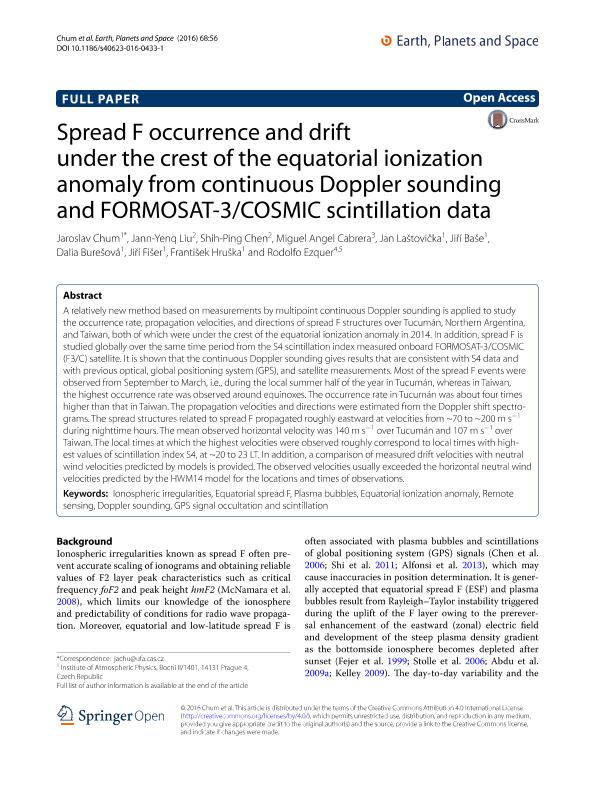Mostrar el registro sencillo del ítem
dc.contributor.author
Chum, Jaroslav
dc.contributor.author
Liu, Jann Yenq
dc.contributor.author
Chen, Shih Ping
dc.contributor.author
Cabrera, Miguel Angel

dc.contributor.author
Laštovička, Jan
dc.contributor.author
Baše, Jiří
dc.contributor.author
Burešová, Dalia
dc.contributor.author
Fišer, Jiří
dc.contributor.author
Hruška, František
dc.contributor.author
Ezquer, Rodolfo Gerardo

dc.date.available
2018-09-03T18:02:30Z
dc.date.issued
2016-04
dc.identifier.citation
Chum, Jaroslav; Liu, Jann Yenq; Chen, Shih Ping; Cabrera, Miguel Angel; Laštovička, Jan; et al.; Spread F occurrence and drift under the crest of the equatorial ionization anomaly from continuous Doppler sounding and FORMOSAT-3/COSMIC scintillation data; Springer; Earth, Plants and Space; 68; 56; 4-2016; 1-18
dc.identifier.issn
1343-8832
dc.identifier.uri
http://hdl.handle.net/11336/58088
dc.description.abstract
A relatively new method based on measurements by multipoint continuous Doppler sounding is applied to study the occurrence rate, propagation velocities, and directions of spread F structures over Tucumán, Northern Argentina, and Taiwan, both of which were under the crest of the equatorial ionization anomaly in 2014. In addition, spread F is studied globally over the same time period from the S4 scintillation index measured onboard FORMOSAT-3/COSMIC (F3/C) satellite. It is shown that the continuous Doppler sounding gives results that are consistent with S4 data and with previous optical, global positioning system (GPS), and satellite measurements. Most of the spread F events were observed from September to March, i.e., during the local summer half of the year in Tucumán, whereas in Taiwan, the highest occurrence rate was observed around equinoxes. The occurrence rate in Tucumán was about four times higher than that in Taiwan. The propagation velocities and directions were estimated from the Doppler shift spectrograms. The spread structures related to spread F propagated roughly eastward at velocities from ~70 to ~200 m s-1 during nighttime hours. The mean observed horizontal velocity was 140 m s-1 over Tucumán and 107 m s-1 over Taiwan. The local times at which the highest velocities were observed roughly correspond to local times with highest values of scintillation index S4, at ~20 to 23 LT. In addition, a comparison of measured drift velocities with neutral wind velocities predicted by models is provided. The observed velocities usually exceeded the horizontal neutral wind velocities predicted by the HWM14 model for the locations and times of observations.
dc.format
application/pdf
dc.language.iso
eng
dc.publisher
Springer
dc.rights
info:eu-repo/semantics/openAccess
dc.rights.uri
https://creativecommons.org/licenses/by/2.5/ar/
dc.subject
Doppler Sounding
dc.subject
Equatorial Ionization Anomaly
dc.subject
Equatorial Spread F
dc.subject
Gps Signal Occultation And Scintillation
dc.subject
Ionospheric Irregularities
dc.subject
Plasma Bubbles
dc.subject
Remote Sensing
dc.subject.classification
Meteorología y Ciencias Atmosféricas

dc.subject.classification
Ciencias de la Tierra y relacionadas con el Medio Ambiente

dc.subject.classification
CIENCIAS NATURALES Y EXACTAS

dc.title
Spread F occurrence and drift under the crest of the equatorial ionization anomaly from continuous Doppler sounding and FORMOSAT-3/COSMIC scintillation data
dc.type
info:eu-repo/semantics/article
dc.type
info:ar-repo/semantics/artículo
dc.type
info:eu-repo/semantics/publishedVersion
dc.date.updated
2018-08-27T19:18:49Z
dc.journal.volume
68
dc.journal.number
56
dc.journal.pagination
1-18
dc.journal.pais
Estados Unidos

dc.journal.ciudad
Nueva York
dc.description.fil
Fil: Chum, Jaroslav. Institute of Atmospheric Physics; República Checa
dc.description.fil
Fil: Liu, Jann Yenq. National Central University. Institute of Space Science; República de China
dc.description.fil
Fil: Chen, Shih Ping. National Central University. Institute of Space Science; República de China
dc.description.fil
Fil: Cabrera, Miguel Angel. Universidad Nacional de Tucumán. Facultad de Ciencias Exactas y Tecnología. Departamento de Electricidad, Electrónica y Computación. Laboratorio de Telecomunicaciones; Argentina
dc.description.fil
Fil: Laštovička, Jan. Institute of Atmospheric Physics; República Checa
dc.description.fil
Fil: Baše, Jiří. Institute of Atmospheric Physics; República Checa
dc.description.fil
Fil: Burešová, Dalia. Institute of Atmospheric Physics; República Checa
dc.description.fil
Fil: Fišer, Jiří. Institute of Atmospheric Physics; República Checa
dc.description.fil
Fil: Hruška, František. Institute of Atmospheric Physics; República Checa
dc.description.fil
Fil: Ezquer, Rodolfo Gerardo. Consejo Nacional de Investigaciones Científicas y Técnicas. Centro Científico Tecnológico Conicet - Tucumán; Argentina. Universidad Tecnológica Nacional; Argentina
dc.journal.title
Earth, Plants and Space
dc.relation.alternativeid
info:eu-repo/semantics/altIdentifier/doi/http://dx.doi.org/10.1186/s40623-016-0433-1
dc.relation.alternativeid
info:eu-repo/semantics/altIdentifier/url/https://earth-planets-space.springeropen.com/articles/10.1186/s40623-016-0433-1
Archivos asociados
